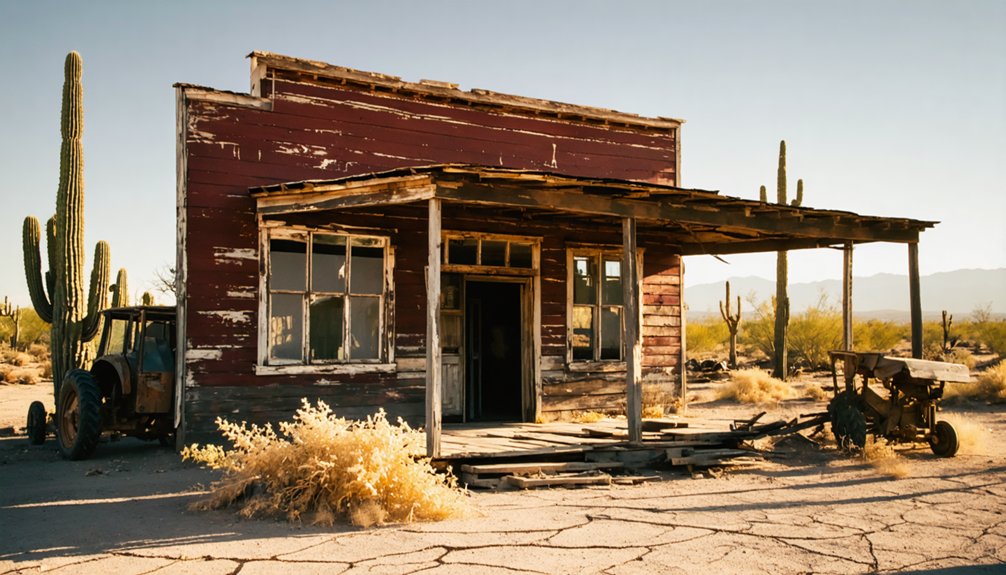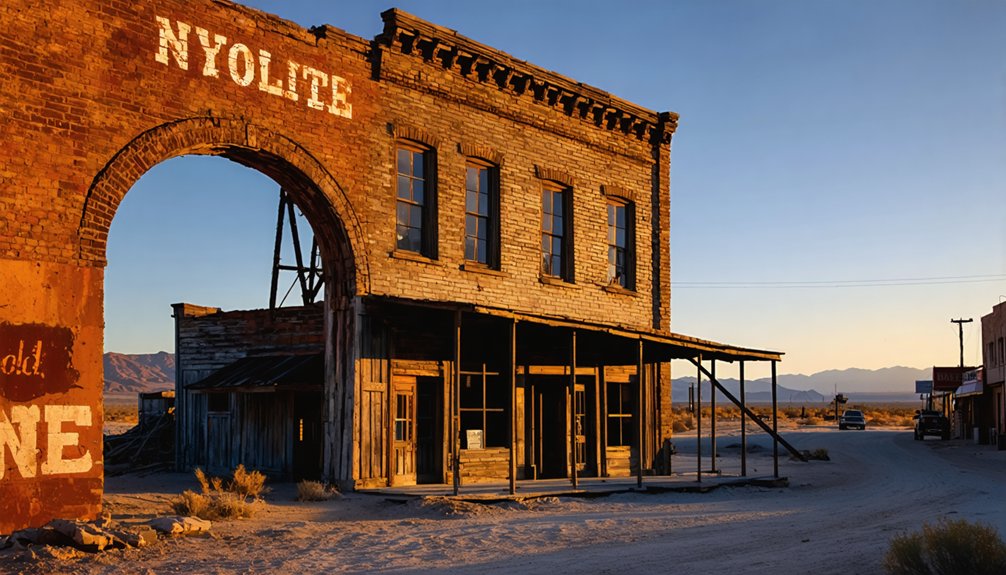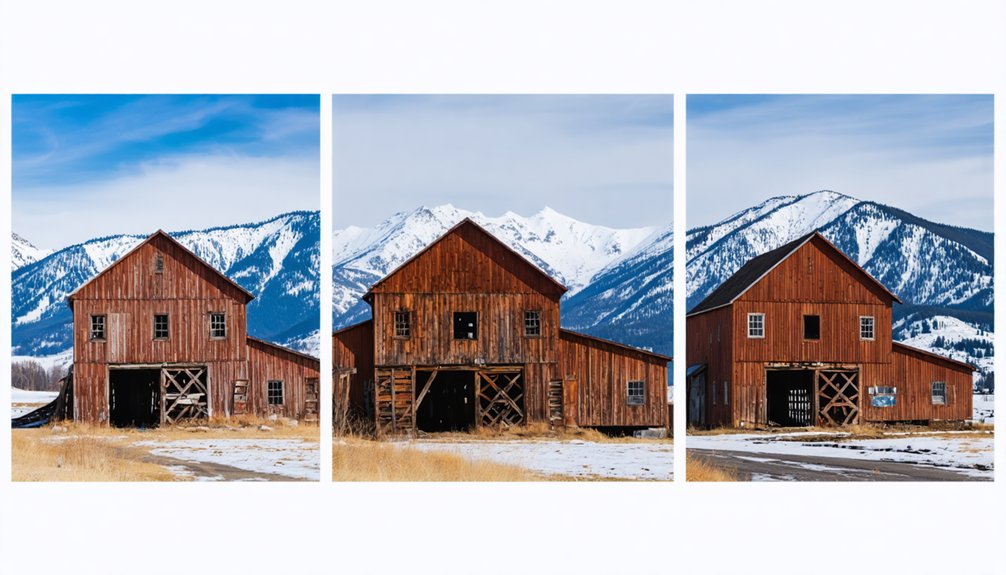You’ll discover America’s most fascinating ghost towns through their compelling industrial ruins, from Centralia’s underground coal fire to Bodie’s gold rush remnants. These abandoned settlements include Kennecott’s 14-story copper mill, Thurmond’s railroad heritage, and Picher’s toxic mining legacy. You can explore Rhyolite’s bottle house, Silver City’s Victorian architecture, Lynch’s coal camp history, and Goldfield’s Wild West charm. Each site’s architectural features and historical significance tell a unique story of America’s boom-and-bust era.
Key Takeaways
- Rhyolite, Nevada features impressive ruins including a three-story bank and the unique Tom Kelly Bottle House from its 1904 mining peak.
- Silver City, Idaho preserves 75 Victorian-era structures and generated $60 million in precious metals during its seven-decade mining boom.
- Bodie, California reached 10,000 residents and produced $38 million in precious metals between 1877-1882 during its gold rush peak.
- Picher, Oklahoma supplied over half of America’s wartime lead and zinc, generating $20 billion before environmental contamination forced evacuation.
- Lynch, Kentucky housed 10,000 immigrant workers from 38 countries as the world’s largest company-owned coal camp in 1917.
The Underground Inferno: Centralia, Pennsylvania
While many ghost towns fade slowly into obscurity, Centralia, Pennsylvania stands apart as a town literally burned from existence by an underground inferno that’s raged since 1962.
What began as a routine trash fire in an abandoned strip mine ignited an extensive network of coal seams beneath the town’s streets. The underground fire quickly spiraled beyond control, releasing toxic gases through cracks in the streets and basements of homes.
Once home to 3,000 residents, this former mining hub now stands nearly empty, its infrastructure destroyed by intense heat and ground subsidence. The Assumption of the Blessed Virgin Mary remains the only active church still conducting services in the area.
A ghost town reduced to ashes and emptiness, Centralia’s crumbling streets tell the story of 3,000 lives uprooted by disaster.
Visitors and explorers often document their journey to see the graffiti highway, where colorful artwork covers a buckled road surface made unstable by the fire below. You’ll find buckled roads, steam vents, and dangerous sinkholes throughout the condemned landscape. Though most residents accepted government buyouts, a few defiant locals remain, living alongside the smoldering ruins of what was once a thriving coal town.
Gold Rush Remnants: Bodie, California
After gold was discovered east of the Sierra Nevada Mountains in 1859, Bodie transformed from a small prospecting camp into one of California’s largest boomtowns.
When a rich gold vein was exposed in 1875, the town exploded with growth, reaching nearly 10,000 residents by 1880. At its peak, you’d find 2,000 buildings, including 65 saloons, hotels, and a thriving Chinatown district. The town earned its reputation as one of the West’s most notorious settlements, with locals known as Badmen from Bodie.
Today, you can explore one of America’s best-preserved ghost towns, with over 170 original structures maintained in “arrested decay.” Located in a region known for its bone-dry summers, the town endured extreme weather conditions that tested its residents’ resilience.
The buildings stand exactly as they were abandoned, complete with furniture and mining artifacts inside. This former gold mining powerhouse, which produced $38 million in precious metals from 1877 to 1882, now serves as California’s official gold rush ghost town, offering an authentic glimpse into Wild West history.
Copper Kingdom: Kennecott, Alaska
Deep in Alaska’s wilderness, the discovery of an extraordinarily rich copper deposit in 1900 launched one of America’s most ambitious mining ventures.
The industrial heritage of Kennecott showcases the sheer determination of early prospectors who transformed this remote location into a $200 million copper empire. You’ll find the towering 14-story mill still standing, where miners once processed the world’s richest copper ore, yielding an astounding 70% pure copper. When operations ceased, miners left behind their tools and equipment, departing hastily on the final train.
The Alaska Syndicate’s investment of $25 million between 1905 and 1911 made this remote mining operation possible. The site’s remarkable preservation lets you explore the company town’s remains, from the hospital to the recreation hall, frozen in time since the last train departed in 1938.
Now protected as a National Historic Landmark within Wrangell-St. Elias National Park, Kennecott’s abandoned structures and machinery tell the story of this remarkable copper discovery that shaped Alaska’s mining history.
Railroad Legacy: Thurmond, West Virginia
Hidden within the New River Gorge, Thurmond stands as one of America’s most compelling railroad ghost towns. This former powerhouse of railroad history handled more freight than Richmond and Cincinnati combined during its peak, with eighteen train crews operating from its strategic position along the Chesapeake & Ohio Railroad mainline.
The town generated $4.8 million in revenue by 1910, representing a remarkable 20% of all C&O Railroad’s total freight earnings.
- The town’s prominence in coal transportation made it the only refueling stop along a 73-mile stretch, serving numerous mines via the Loup Creek branch line.
- At its height, Thurmond’s economic significance supported West Virginia’s wealthiest banks and employed over 150 railroad workers.
- Today, the National Park Service preserves more than 20 historic structures, including the restored railroad station, National Bank, and Lafayette Hotel.
While only five residents remain, Amtrak still services this remarkable representation of America’s industrial heritage three times weekly.
Mining’s Toxic Legacy: Picher, Oklahoma
While most ghost towns fade quietly into history, Picher, Oklahoma stands as America’s most catastrophic example of environmental devastation from mining. Founded in 1913, this boomtown supplied over half of America’s lead and zinc during both World Wars, reaching a peak population of 20,000. The mines generated over $20 billion in mineral wealth during their peak production years.
The toxic contamination left behind transformed Picher into an environmental nightmare. Massive chat piles of mining waste poisoned the land and water, while underground tunnels collapsed, creating treacherous sinkholes throughout the town. A 2006 study revealed that 159 local structures were at risk of collapse due to undermining.
The health impacts were severe – children suffered developmental problems from lead exposure, while miners battled silicosis and lung cancer. By 2009, federal authorities had evacuated the remaining residents, leaving behind a wasteland of condemned buildings and contaminated soil.
Today, you’ll find only toxic remnants of this once-thriving industrial powerhouse.
High-Altitude Abandonment: Gilman, Colorado
Mining towns may rise and fall, but few match the dramatic setting of Gilman, Colorado, perched precariously on a 600-foot cliff above the Eagle River. Founded in 1886 during the silver boom, this high-altitude haven at 9,938 feet transformed from silver mining to zinc, lead, and copper production over its century-long operation.
John Clinton, a local prospector and judge, developed the town in the 1880s with a vision for a thriving mining community.
- The town’s infrastructure supported 1,000 residents with amenities like schools, stores, and saloons, while the Denver and Rio Grande Railroad facilitated ore transport.
- Environmental devastation forced evacuation in 1984-85 when toxic mine runoff contaminated groundwater and soil.
- Today’s remaining structures stand as silent sentinels to mining memories, though high altitude hazards and contamination keep this ghost town strictly off-limits.
You’ll need to admire this industrial relic from designated pull-offs on Highway 24, as the site remains private and dangerous.
Ghost Rails: Rhyolite, Nevada

Deep in the Mojave Desert, Rhyolite stands as one of Nevada’s most spectacular ghost towns, where the discovery of gold in 1904 transformed a two-tent mining camp into a bustling metropolis of 5,000 residents.
You’ll find impressive Rhyolite ruins including a three-story bank building, railroad depot, and the unique Tom Kelly Bottle House – all monuments to the town’s brief prosperity.
Silver City Shadows: Silver City, Idaho
You’ll discover Silver City’s remarkable evolution from its 1864 founding through its peak of 2,500 residents around 1900, when it boasted over 60 ore-processing mills and Idaho’s first newspaper.
The town’s architectural legacy remains intact with 75 original Victorian-era structures, including the still-operating Idaho Hotel, which stands as proof of the $60 million in precious metals extracted from the surrounding mountains.
As one of America’s best-preserved ghost towns at 6,200 feet elevation, Silver City offers you an authentic window into frontier life, where every building, from the 1869 Masonic Lodge to the museum-converted schoolhouse, tells a story of the American West.
Mining Heyday Historical Timeline
When Michael Jordan’s mining party discovered the Owyhee mines in 1863, they set in motion Silver City’s meteoric rise as one of Idaho’s most prosperous mining settlements.
Within two years, mining techniques advanced rapidly as the Washoe process revolutionized silver production, leading to over 250 active mines and 12 ore-processing mills.
- By 1865, you’d find miners staking multiple 900-foot claims, while Fort Baker stood as a symbol of the fierce competition for mineral rights.
- The boom peaked in the 1880s with 2,500 residents and 75 thriving businesses.
- Silver City’s strategic location at 6,200 feet in the Owyhee Mountains yielded an astounding sixty million dollars in precious metals over seven decades.
The town’s prosperity brought modern amenities, including telegraph service in 1874 and the iconic Idaho Hotel, which still stands today.
Preserved Victorian Architecture Today
Standing as a remarkable demonstration to America’s mining era, Silver City’s collection of approximately 70 original Victorian buildings offers visitors an authentic glimpse into 1860s frontier architecture.
You’ll find exceptional examples of Victorian preservation, including the 1892 Folk Victorian schoolhouse, the 1869 Masonic Lodge, and the still-operational Idaho Hotel.
The Historic Silver City Foundation has invested over $325,000 in restoration efforts, earning recognition from Preservation Idaho through their 2012 Orchid Award.
Each structure maintains its architectural significance through careful restoration of period details like decorative sheet metal window pediments and original doors.
Perched on hills above Jordan Creek, these weathered yet dignified buildings continue to tell the story of America’s mining heritage, protected by their remote mountain location and strict preservation guidelines.
Modern Ghost Town Experience
Deep within Idaho’s rugged Owyhee Mountains lies Silver City, a remarkably authentic ghost town where visitors can experience one of America’s best-preserved mining settlements.
Unlike many over-commercialized ghost towns, Silver City’s commitment to historical preservation has maintained its 1800s character, with about 70 original structures still standing at 6,200 feet elevation.
During your urban exploration adventure, you’ll discover:
- An operational 1860s Idaho Hotel featuring period furnishings and modern amenities
- The active 1869 Masonic Lodge where community meetings still take place
- An 1898 church and museum housed in the former schoolhouse, showcasing mining-era artifacts
You’re free to roam the unchanged town layout, where no buildings have been constructed since 1890, offering an authentic glimpse into frontier life without modern developmental intrusions.
Coal Dust Memories: Lynch, Kentucky
The mighty coal empire of Lynch, Kentucky began in 1917 when U.S. Steel’s subsidiary established what would become the world’s largest company-owned coal camp.
Birthed in eastern Kentucky’s mountains, Lynch grew from a U.S. Steel vision into coal mining’s grandest company town.
You’ll find this industrial heritage site nestled on 19,000 acres near the Virginia border, where cutting-edge mining technology once powered America’s steel industry. At its peak, Lynch’s fully electric mines set world records, shipping 12,880 tons of coal in a single shift.
Today, you can explore the haunting remnants of this coal mining powerhouse, where abandoned tipples and mine portals stand as silent sentinels to a bygone era.
While fewer than 700 residents remain, Lynch’s well-preserved architecture tells the story of 10,000 immigrant workers from 38 countries who once called these mountains home, making it one of Kentucky’s most intact company towns.
Desert Dreams: Goldfield, Arizona

You’ll find Goldfield’s mining glory days preserved in its restored buildings, where the 1890s gold rush brought 1,500 residents and a bustling array of saloons, shops, and essential services.
The town’s authentic Wild West architecture stands as proof to both its dramatic five-year boom and eventual bust, including the original Mammoth Mine tunnel that fueled its rapid growth.
Today’s visitors can experience this meticulously restored ghost town along the Apache Trail, complete with period-accurate structures, an operational museum, and reports of paranormal activity that add to its historical intrigue.
Mining Glory Days Past
Nestled between the Superstition and Goldfield Mountains, Goldfield, Arizona emerged in 1892 as a promising gold mining settlement that would quickly transform into one of the region’s most productive boomtowns.
The discovery of high-grade gold deposits sparked an economic surge that attracted thousands of fortune seekers, with the town’s population swelling to 4,000 residents at its peak.
- The Mammoth Mine anchored the town’s boomtown economics, offering lucrative wages of $5 per day.
- Mining operations yielded some of the highest-quality gold samples ever discovered in the region.
- The rapid expansion created a self-sustaining economy with essential services including a brewery, hotel, post office, and multiple saloons.
You’ll find that Goldfield’s meteoric rise exemplified the quintessential Western mining town, where ambitious prospectors carved civilization from the desert landscape.
Preserved Wild West Buildings
Standing as a tribute to the Old West’s architectural heritage, Goldfield Ghost Town‘s preserved buildings offer visitors an authentic glimpse into 1890s frontier life.
You’ll discover meticulously reconstructed structures spanning 45 acres, including the iconic Main Street’s Mercantile building and Mammoth Steak House. The historical restoration showcases period-appropriate materials like adobe, wood, and corrugated metal throughout the town.
Goldfield’s architecture reflects every aspect of frontier living, from the stately Church at the Mount to the notorious Bordello.
Industrial features include Arizona’s only operating 3-foot narrow-gauge railroad and the preserved mine tower. While most buildings are replicas, they’re built using historical photographs and maps as guides, ensuring authentic representation of 1890s desert mining town construction techniques.
The Spanish-style house and Water Tank stand as evidence of the region’s diverse architectural influences.
Modern Tourist Experience Today
Today’s visitors to Goldfield Ghost Town discover an immersive blend of historical authenticity and modern entertainment spanning 45 acres of restored frontier territory.
You’ll find yourself transported to the 1890s through carefully preserved architecture and engaging live performances, while modern attractions guarantee a comfortable experience.
Key immersive experiences include:
- Underground mine tours and gold panning stations that let you experience authentic prospecting techniques
- Theatrical gunfights and costumed interpreters who bring the Wild West to life through daily performances
- Historical exhibits at the Goldfield Museum combined with modern thrills like the Superstition Zipline
Located just 4.5 miles from Apache Junction along the scenic Apache Trail, you can easily access this living museum where authentic Western heritage meets contemporary amenities.
The panoramic desert vistas and Superstition Mountain backdrop create an unforgettable frontier atmosphere.
Frequently Asked Questions
Are There Any Ghost Towns That Still Have Active Mining Claims?
You’ll find active mining claims in several ghost towns, including Vulture City, Arizona, where the Vulture Mine operates, and Castle Dome’s mining district, which maintains periodic mineral extraction activities.
What Safety Precautions Should Visitors Take When Exploring Abandoned Industrial Towns?
You’ll avoid a million hazards by wearing proper safety gear: boots, gloves, respirator, and headlamp. Check local regulations before entering, and never explore unstable structures or restricted areas alone.
Can You Legally Collect Artifacts From These Ghost Towns?
You can’t legally collect artifacts without proper permits and landowner permission. Legal regulations strictly protect ghost town sites for artifact preservation, with violations resulting in significant fines and potential imprisonment.
Which Ghost Towns Are Most Accessible During Winter Months?
Like snow-dusted sentinels, Bodie and Thurmond offer you the easiest winter accessibility, with plowed roads and open facilities. You’ll find guided ghost town tours in Bodie, while Thurmond allows self-guided exploration.
Do Any Former Residents Organize Reunions at These Abandoned Towns?
You’ll find former residents organizing reunion events in several ghost towns, including Bodie’s heritage tours, Thurmond’s railroad gatherings, and Centralia’s annual remembrances of their mining community’s past.
References
- https://www.loveexploring.com/gallerylist/131658/abandoned-in-the-usa-92-places-left-to-rot
- https://www.youtube.com/watch?v=eyOASXxAmMI
- https://en.wikipedia.org/wiki/Wikipedia:WikiProject_Ghost_towns
- https://shirleendavies.com/ghost-towns-and-boom-towns-of-the-american-west/
- https://www.thetravel.com/us-ghost-towns-that-are-still-abandoned/
- https://www.geotab.com/ghost-towns/
- https://handbill.hk/editor_upload/file/1f47de58-e829-419c-ab5d-deae4a07d2ca.pdf
- https://money.howstuffworks.com/10-boom-towns-that-went-bust.htm
- https://en.wikipedia.org/wiki/Ghost_town
- https://www.atlasobscura.com/lists/united-states-of-abandoned-places



